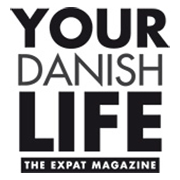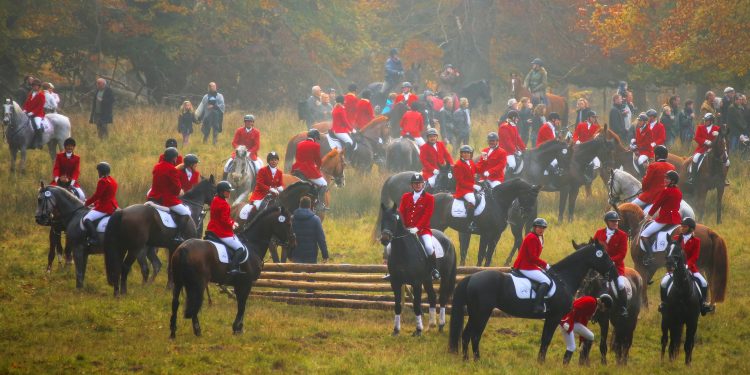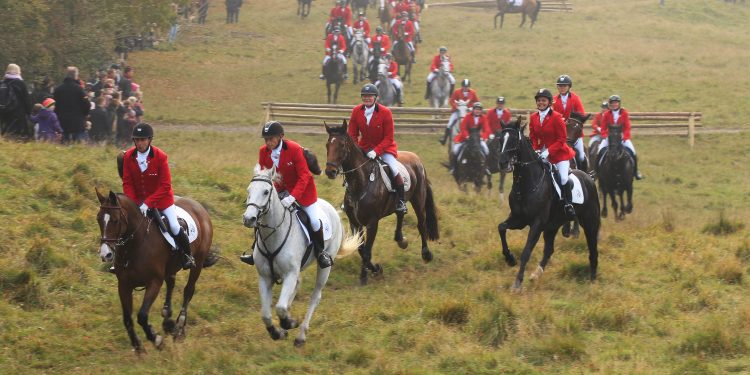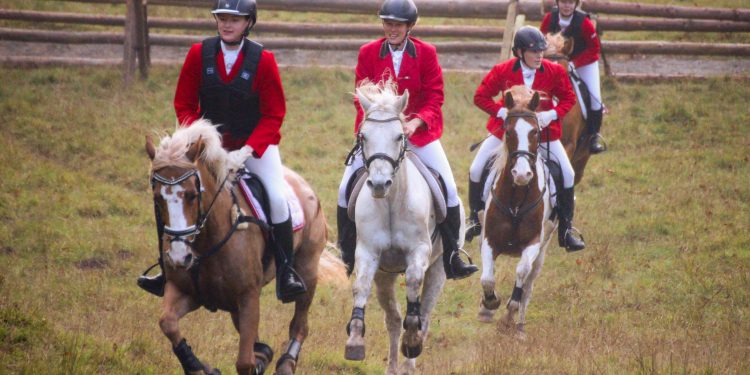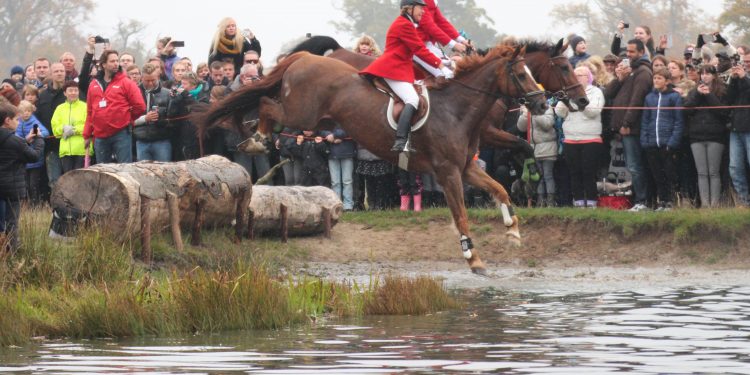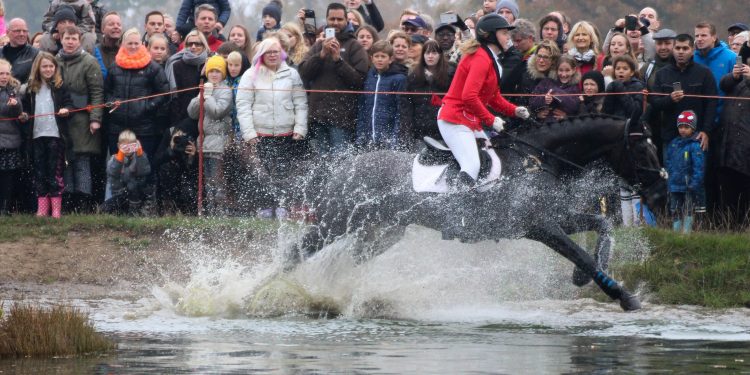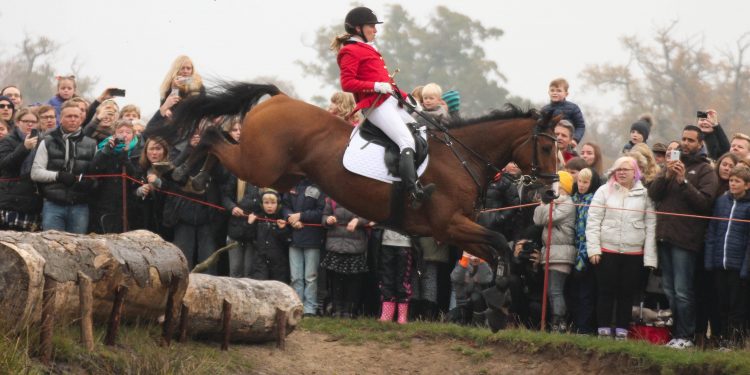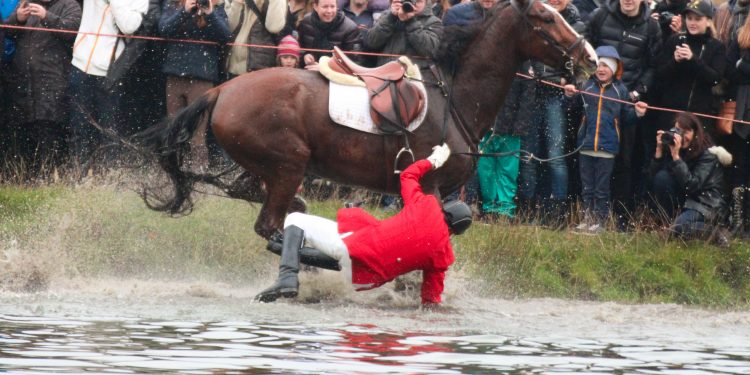A great event the annual hunt, Hubertusjagten
It is the picnic of the year, and it takes place every first Sunday in November. This year on SUNDAY 3rd November expect a large audience in Dyrehaven, North of Copenhagen.
The article continues below.
By Bente D. Knudsen Pictures: Hisham Ammar
This year, the Danish King and Queen are unable to attend, so instead it will be H.M Queen Margrethe who will hand over the main prize, she has been announced as participant, whether she will be joined by one or more of her younger family members has not been announced.
Arriving (and leaving again) in a horse-drawn carriage from the Royal Stables, she will join in the fun of watching the hunt.
The article continues below.
The riders and horses are a great sight to see as they come charging full gallop towards the jump, red riding coats, shiny harness, all ready to give their best, and intensely competing to become this year’s champion.
The name Hubertusjagt is derived from the Bishop Hubert, who died on 3 November 728 and became Saint Hubert by order of the Pope.
At the time, and for many centuries afterwards, hunting on horseback was for kings and noblemen.
However, in Denmark, the Hubertus hunt, more or less as we know it today, was first organised at the turn of the 20th century in Copenhagen by local riding clubs enjoying hunting from horseback.
Today, the hunting sport on horseback takes place several times a year, but only as closed events for members of their clubs.
The last hunt of the year is the one in Dyrehaven, and it is the only existing public event, which offers a great opportunity for everyone to experience the fascinating and slightly dramatic sight of horses at full speed, flying through the air, fighting to keep their balance at the steep landing on the other side of the obstacles.
The article continues below.
It’s the main outing for Copenhageners
The Copenhagen event has taken place since 1905, organised by the riding club Sportsrideklubben in Charlottenlund. It’s the autumn event in Dyrehaven, the deer park in Klampenborg about 10 km north of Copenhagen.
More than 160 riders participate in the hunt.
For many Copenhageners, up to 40,000 of them, it has become a tradition; getting up early on that November Sunday, dressing warmly, and setting off to get the best place as close as possible to the hunting route.
For some, only a front row place at Magasindammen counts. This is where the assembled crowd, having hoped for rain in the weeks before the hunt, so the small pond is full of water, wait to see which rider will fall in this year and take a dip in the muddy water.
If the pond contains a large amount of water, it is even more challenging for riders and horses to pass, and more dramatic and fun for the audience to watch.
Others prefer watching riders jump over the difficult obstacles, more than 35 in total, along the route, particularly in Ulvedalene. On this day, the deer seek out the grounds furthest from the hunt to hide from the crowd, or simply ignore all the visitors and proceed in their usual way.
The winners from the different categories – there is also a pony category – receive their prizes in a ceremony in front of Eremitage Slottet.
The first prize awarded is H.M Queen Mary’s Ærespræmie (prize of honour). It will be H.M Queen Margrethe who will hand over the prize.
For lovers of animals – No deer or foxes are being hunted
None of the Hubertus hunts taking place are in any way dangerous for deer or fox, as no “real” wild animal is being chased. Instead, normally one or two front riders, bearing a fox’s tail on their red riding coat, lead the way, and pretend to be hunted.
So you can easily join in for the fun on this particular day, where the public is invited to join in.
You need not worry about the poor fox. However, the deer park is crowded for this event – so don’t expect to see much of mother nature on this day. Go instead on another day to enjoy the sight of the park and it’s many deer.
Sunday 3 November 2024
It ends at the hunting lodge – Eremitageslottet – where a member from the royal family hands over the prizes to the winners.
The article continues below.
The Copenhagen Deer Park – Dyrehaven
A great excursion during the autumn months it to take a walk, bike ride or horse carriage ride in this old, royal deer park. You can even go on horseback if you enjoy riding, and at Fortunen’s Riding School you can rent both ponies and horses by the hour.
Dyrehaven and the Eremitage Hunting Castle belonged to the Royal family, and the deer were fenced in, in 1669, by King Frederik III – so the King could easier hunt the deer. Today it is a public park with more than 2,100 deer of various kinds. It is a unique site, where you can get a really close look at Bambi and his parents.
The autumn and winter seasons are great to do so because the deer are fed at several sites from where the audience can get quite close (while maintaining a respectful distance).
As the deer have no natural enemies in the park, and 700 fawn are born each spring, during the winter months, more than 700 deer have to be shot to keep the park at its 2,100 limit. The tasty venison is sold to local inhabitants and restaurants. Some deer are caught and exported live to other deer parks.
The deer in Dyrehaven are considered to be world class and during the rutting season, you will find nature lovers, photographers, and journalists alike flocking to get an up-close look at the male deer, the stags.
According to Naturstyrelsen, responsible for the public park, Royal stags can be seen rutting in the southern part of the park from the middle of September to the beginning of October, whereas the rutting fallow deer will usually be on the Eremitage Plain around the end of October and the beginning of November. Keeping a distance and avoiding disturbing them is highly recommended however.
Take your bicycle with you to the deer park. You can easily take your bicycle with you on the S-train to Klampenborg Station and cycle through the park.
Support our magazine with a contribution of any size
We do not want to put up a pay-wall, so we need your support and if you find our content relevant and worthwhile, we would value any contribution, however big or small, as a token of your appreciation of our efforts.
How to support:
Transfer any contribution to our bank account at: Your Danish Life/ Danish Expat Media Aps
Danske Bank Account number: 3409 11405673
IBAN: DK68 3000 0011 4056 73
or MobilePay to 2144 1224
Message: Support
Deer Park Info
More than 1,700 fallow deer can be seen grouping together in herds as large as several hundred, and can usually be seen on the open plains.
Their coats can be three different colours: black, white or a brownish-red. However, the brownish-red coats are the most common.
The deer were introduced from the Middle East and are mentioned in written sources as roaming about freely in Denmark as far back as 1231.
About 100 sikas complement the other two species. They are a little smaller than fallow deer. Their summer coat is a chestnut colour with whitish-yellow spots, whereas their winter coat is an even dark brown (females) and black (males).
This breed, which has been in the Deer Park since 1923, was introduced from Japan. Source: Naturstyrelsen
